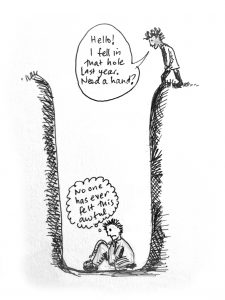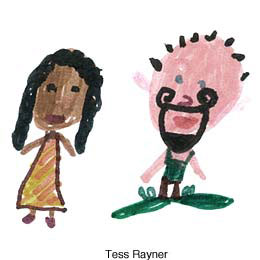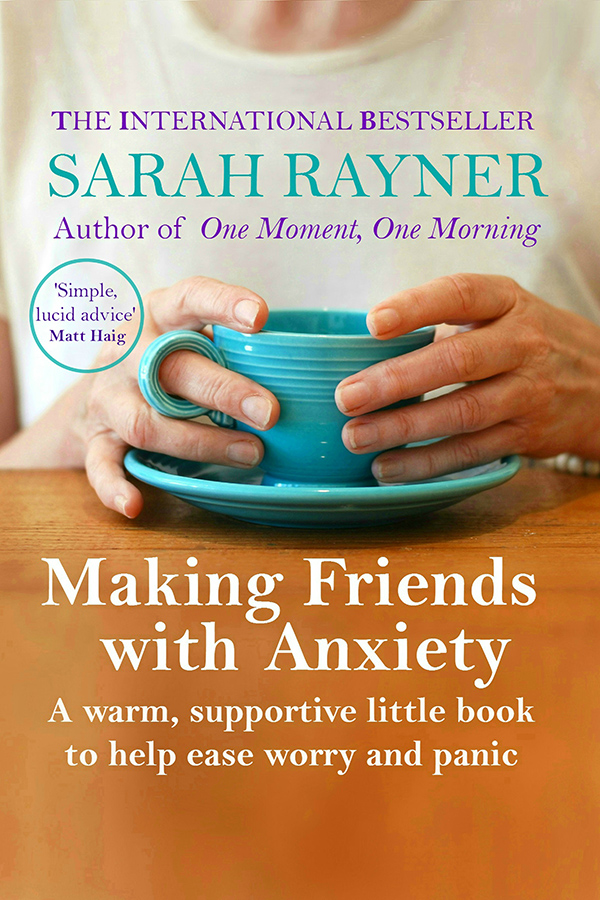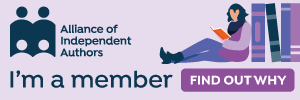Want to publish your book yourself? 12 things to consider before you start
 Let me cut to the chase. There is a huge amount out there about self-publishing, and I don’t want to double up on what other authors have already shared when a few links can point you in their direction, so you’ll find the links below. Plus there’s a limit to how much I want to write about self-publishing. It strikes me that self-publishing a book on self-publishing is a bit like looking in parallel mirrors, you know when you see endless pictures of yourself, repeated ad infinitum into the distant darkness? My grandmother had a set of mirrors like that, and they always seemed downright spooky to me. So, here are 12 things that I have learned self-publishing my ‘Making Friends…’ series of self-help books and my novel The Other Half that I hope add to the discourse and are helpful.
Let me cut to the chase. There is a huge amount out there about self-publishing, and I don’t want to double up on what other authors have already shared when a few links can point you in their direction, so you’ll find the links below. Plus there’s a limit to how much I want to write about self-publishing. It strikes me that self-publishing a book on self-publishing is a bit like looking in parallel mirrors, you know when you see endless pictures of yourself, repeated ad infinitum into the distant darkness? My grandmother had a set of mirrors like that, and they always seemed downright spooky to me. So, here are 12 things that I have learned self-publishing my ‘Making Friends…’ series of self-help books and my novel The Other Half that I hope add to the discourse and are helpful.
- Before you venture into self-publishing, take a long, hard look at yourself. Ask yourself if you’re good at networking, highly organised and prepared to blow your own trumpet. If the answer is ‘no’ to any of these, I’d say self-publishing is probably not for you, unless you’re not bothered about selling many (possibly any) copies. Some people aren’t I suppose, (maybe you don’t need to earn any income from your venture, but simply want to get your creative work read by friends and family and are after an easy format to help them do so). But if your ambitions are greater than that, you’ll need to network – like MAD – if you’re to self-publish your book and sell copies of it in any significant numbers. Even if you give it away for nothing, there is so much available already that you won’t have a hope in Hades of being read. Free Kindle books are … well, I was going to say ‘a dime dozen’, but then I realised that was a tautology. Still, you get the gist.
- Be realistic. The average book sells 250 copies a year. Not a week, or month, a year. And that’s in the U.S., where there are more potential readers. If you’re happy with those sort of figures, fine, but if you feel you’ve something important, fresh and different to say and are expecting to sell copies by the shedload, please remember that for every 50 Shades, there are hundreds of thousands of books that are self-published each year. Rein in your expectations and be prepared to work damn hard. Still interested? Great. Next…
- Read all you can about self-publishing. Unfortunately many of the books on how to self-publish are so full of puff and self-congratulation as to be hard to stomach, especially if you’re cynical Brit, like me.The whole ‘make a million on Kindle’ line is a fallacy. I also find these gushing tomes often take 100-odd pages to say what could be delivered in 20. Not so this little book by Kate Harper, however, which is incisive, sensible and well put together. It told me everything I wanted to know about publishing on Kindle and a few things I didn’t think I wanted to know but needed to. Don’t be misled by the title – its use extends beyond guiding those wishing to publish articles. How to Publish and Sell Your Article on Kindle is relevant to anyone writing a shorter book – be it poetry, non-fiction or whatever, much of what Kate Harper advises is applicable. In summary, if you’re looking for a book about publishing on Kindle, buy this one.In addition, let me introduce you to two bloggers. Catherine Ryan Howard, who has been self-publishing for many years with great success – I found her insights indispensable. There is also Joanna Penn, who knows just about all there is to know about growing and nurturing
 a list: http://www.thecreativepenn.com/.
a list: http://www.thecreativepenn.com/. - Start small. It’s much easier to learn how to self-publish (and make the inevitable mistakes) if you’ve set yourself a little hill to climb, not Everest. You can test the water in terms of your readership, experiment with pricing, make changes to the content and design of your book and start building a name for yourself, without having to spend years writing a magnum opus. Also, if you fall flat on your face and fail (maybe everyone hates your book and you wish you’d never attempted to self-publish), at least you won’t have invested so much time, energy and money. (Even if you don’t shell out for any of the ‘extras’ I mention in points 9 and 11, time and energy are money, so this venture will cost you somehow.) Plus you can ascertain if self-publishing suits you – your skill set and your personality (see 1). It suits me, but it doesn’t suit every author.
- Don’t rule out print. If you’re one of the many who assume that self-publishing = e-books, darling reader, let me disavow you of this notion. Kindle books aren’t selling quite what they used toand although it’s primarily the big publishers who are experiencing this downturn, my own sales do figures verify this. It’s less than two years since I first ventured into self-publishing, and when I initially released Making Friends with Anxietyin 2014, it was selling three digital copies to every one in print. Now it’s the other way round; Making Friends with Anxiety is currently selling more than double the number of print copies for each digital sale. Sales trends in publishing change fast.Moreover, just because your book is self-published it doesn’t mean a print version needs to look amateur. Below is the interior of Making Friends with the Menopause – better quality than you might think a ‘print on demand’ book would look. So print should be part of your plan.All this said, you might like to start with a digital version of your book as it’s the swiftest and easiest way to get your book out there, and you’re starting small to test the waters, remember?
- Every book needs a Unique Selling Point (see Advice on Fiction/Advice on Non-Fiction for a fuller explanation), but if you’re going to self-publish, you need to think about your USP in the context of your shop window being online. The big – and I mean huge – drawback of self-publishing is distribution, or, to put a different spin on it, the big publishing houses still have the upper hand when it comes to getting stock into bricks-and-mortar stores. High street retail outlets so rarely take stock by indie authors in large quantities that you might as well wave goodbye to factoring that option into your plan, for now at least. You may get your local bookshop to sell a few copies, but I could buy a latte and a bun and little more from what I’ve sold through my local bookshop, City Books in Brighton, grateful though I am to them for stocking my self-published tomes. On the other hand, I’ve sold approaching 30,000 self-published books through Amazon to date. Big difference, no? This upshot of all this means that it’s very important that you understand how ‘search’ tools work, especially on Amazon, as the ‘BISAC’ category you sell your book under online will have a big impact on what you actually write about – i.e. the genre and subject of your book; the title of your book, the marketing of your book, the connection you make with a potential readership and the number of sales you make long term. Amazon’s search engine works differently to Google, and this article gives a useful overview, but the overriding thing you need to know is that if you can narrowly target your audience, you are much more likely to reach them and sell in big numbers. You’re not in a bookshop, remember, and you’ve got to rely on people finding your books, when Amazon list millions. So you need to put yourself into the mindset of your reader, and think ‘are they likely to search for my novel/non-fiction book and find it?’ Let me give you a specific example. The reason I decided to start with non-fiction (rather self-publish a novel) is that I realized even though I am relatively well established as a novelist, readers were still unlikely to find me if they searched for a new novel of mine online unless they used my full name. In other words, they’d have to be looking for me specifically, rather than browsing and coming across me as they would when a new novel of mine is displayed in a bookshop. My novels fall into the category ‘contemporary fiction’, and it’s such a broad one that in it my titles are competing with tens of thousands of others. This means that within that category, they are way down the rankings, even though they sell relatively well. Were I to launch a novel with ‘contemporary fiction’ as an online listing and thus my primary shop-window, it would be like putting a thimble-sized book in the window of one branch of Waterstones, and expecting its presence to make that book a Sunday Times bestseller.
 Whereas ‘Anxiety’ is a whole different BISAC game. I knew (because when I was suffering from bad anxiety I did it myself), that when people are anxious and panicky, they go into Amazon search facility and type ‘anxiety’ in the hopes of finding a book to help. You can put this to the test and try it now. See what happens? There, unless I’m mistaken, is Making Friends with Anxiety, hopefully somewhere near the top.This very basic understanding of ‘search’, coupled with the fact I was keen to help as many people with mental health issues as possible, is what led me to write and self-publish the little book. Now you’ve given proper thought to your U.S.P., you are finally ready to…
Whereas ‘Anxiety’ is a whole different BISAC game. I knew (because when I was suffering from bad anxiety I did it myself), that when people are anxious and panicky, they go into Amazon search facility and type ‘anxiety’ in the hopes of finding a book to help. You can put this to the test and try it now. See what happens? There, unless I’m mistaken, is Making Friends with Anxiety, hopefully somewhere near the top.This very basic understanding of ‘search’, coupled with the fact I was keen to help as many people with mental health issues as possible, is what led me to write and self-publish the little book. Now you’ve given proper thought to your U.S.P., you are finally ready to… - ….write your book. It may seem late in the day to get onto the subject of writing, but I firmly believe there is no point starting to draft your non-opus only to find you have to change your horses midway, or worse, pull out of the race completely, and unless you’re clear about points 1 to 7 beforehand, that may well be the result. So put finger tips to keyboard, and get drafting, and when you’re done, make sure your book is as good as it can possibly be. But this is not a piece about writing, or editing: it’s about self-publishing, so if you’re keen for insights on writing fiction, let me redirect you here, and if your book is non-fiction, the advice on that is here.
- Once your book is written and you’ve rewritten it not once, twice, but ten times, then get it edited and proof read by professionals. Every author benefits from the input of a good editor, and no author can spot typos in his or her own work. Whatever your budget and however good you are slaying your darlings, just do it, because it’s simply not possible to see when you are guilty of overwriting and notice every single grammatical mistake or repetition yourself. It will mean you have to outlay some money, but in my experience neither service is that expensive, and they are well worth it.
- Typesetting, on the other hand, is something you can do yourself. If you have determination and patience and a smattering of computer skills, it can be an enjoyable challenge and you can save money. The reason I say this with confidence is that most authors are obsessed with how words look on the page, and that obsession, coupled with an ability to type – even if you use two fingers to do it – will stand you in good stead. Gone are the days when you had to make sure your document was formatted with all sorts of technical code; the tools available on sites such as KDP, CreateSpace, Smash Words etc. are increasingly sophisticated and user friendly, so now what you type on screen is much more closely aligned to what appears on the printed page or screen of an e-reader. As long as you have the correct page set-up (make sure you use mirrored margins for instance, and allow for the gutter in your print version) in Word, you can work hard to make the interior of your book look great without needing assistance from anyone else. You will need to make key decisions about size, paper types and finish so it helps to look at some mainstream-produced books, and other self-published authors may advise differently, of course, but to my mind to shell out for typesetting isn’t necessary. The key is to buy in the services that you don’t feel able to handle alone, and to retain control of your project to make sure you have grasped the main elements of the publication process. Having said this…
- Whether books are published by traditional publishers or self-published, the role of the cover in terms of sales is crucial. Other than your choice of listing (see 7), it’s your cover is your primary marketing tool, even if you’re initially releasing your book digitally, so you may want to buy-in expertise in terms of designing it.
 I design my own covers, but I have a marketing and design background which meant I had a feel for it before I started self-publishing. Certainly the likes of CreateSpace make it much easier to design your own jacket than it would be were you to sit down at a desk with a blank sheet of paper; the site offers cover design templates and walks you through the process step-by-step. But you should be aware that using one of these templates is something other authors will be doing too, so it could give your book a ‘me too’ appearance, and also be mindful that that what works well in a bookshop isn’t necessarily exactly what works best online. Online you need your book to work as a thumbnail first and foremost. In an online retail environment, your design needs to be simpler and your use of contrasts greater. It also needs to work in black and white as some e-readers don’t display colour, though increasingly they do.
I design my own covers, but I have a marketing and design background which meant I had a feel for it before I started self-publishing. Certainly the likes of CreateSpace make it much easier to design your own jacket than it would be were you to sit down at a desk with a blank sheet of paper; the site offers cover design templates and walks you through the process step-by-step. But you should be aware that using one of these templates is something other authors will be doing too, so it could give your book a ‘me too’ appearance, and also be mindful that that what works well in a bookshop isn’t necessarily exactly what works best online. Online you need your book to work as a thumbnail first and foremost. In an online retail environment, your design needs to be simpler and your use of contrasts greater. It also needs to work in black and white as some e-readers don’t display colour, though increasingly they do. - The penultimate piece of the jigsaw is the price of your book. Once you’ve got an idea of your pagination and the size of your book, you can calculate how much you’ll make per copy. I can’t tell you what price to sell your book at, as it depends on so many variables that each title is a law unto itself, but you can gain a good idea of how it works as you don’t need to sign up to Amazon’s CreateSpace book publishing company to have a play with their royalty calculator – you can give it a go here. One of the greatest joys of self-publishing is that it is phenomenally empowering, and puts you in control of your own profit margins.
- And another joy is that with self-publishing, your royalties (i.e. payments received by you) can be much greater per copy. So your shop window might be smaller, but you won’t need to sell as many copies to make the same income. Typically a traditional publishing house will offer around 7% paperback royalty rate, so for every £1 your book earns you will receive 7p, less your agent’s percentage if you have one. With e-books royalties are even greater, so for every £1 you’ll earn 25p. But with self-publishing, I’ve found that if I sell a paperback for a £5, I can make over £1 in royalties, so that’s 20% of the list price, and if you publish on Kindle, you can earn as much as 70%.
And there you have it, my friends. A 12-step programme to set you on the road to self-publishing. You might also like to read the section on the pros and cons of publishing vs self publishing, which is here. Meanwhile I wish you well on your journey, and even if you don’t make a million, enjoy the ride.
 The Making Friends with Anxiety/Depression books, as featured in the Making Friends with Anxiety & Depression group on Facebook
The Making Friends with Anxiety/Depression books, as featured in the Making Friends with Anxiety & Depression group on Facebook
Making Friends with the Menopause

One wonderful thing about self-publishing: you can choose who you collaborate with. Here’s Patrick Fitzgerald, my doctor-friend, who wrote Making Friends with the Menopause with me. My latest venture, Making Friends with Depression, is co-authored by Patrick and bestselling author Kate Harrison. Making Friends with Anxiety: A Calming Colouring book is illustrated (below) by Jules Miller.


 I’ve designed the covers of the books in the Making Friends with… series myself. For More Making Friends with Anxiety (above), I asked a family member to model, and I illustrated Making Friends with Depression myself. I use online software to retouch images and do the typography: www.PicMonkey.com.
I’ve designed the covers of the books in the Making Friends with… series myself. For More Making Friends with Anxiety (above), I asked a family member to model, and I illustrated Making Friends with Depression myself. I use online software to retouch images and do the typography: www.PicMonkey.com.
 2017 sees my first self-published fiction: I’ve reacquired the UK rights to The Other Half and produced a new, illustrated edition.
2017 sees my first self-published fiction: I’ve reacquired the UK rights to The Other Half and produced a new, illustrated edition.

Giving away examples of your work can help to grow your fan base.







OCT
2016


